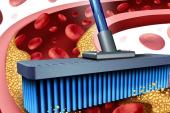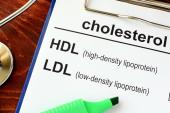For High-Risk Patients Getting Evolocumab in Europe, Other Meds Fall Short
Given Europe’s high LDL bar needed for reimbursement, it’s mostly statin-intolerant who receive the PCSK9 inhibitor.

The PCSK9 inhibitor evolocumab (Repatha; Amgen) cut LDL-cholesterol levels by more than 50% in patients at very high risk of cardiovascular events in the HEYMANS observational study, but almost half weren’t on a statin or ezetimibe, likely because they were intolerant to the drugs.
In this real-world analysis of patients with heterozygous FH (HeFH), only one-third were prescribed a high-intensity statin with ezetimibe while 44.5% weren’t prescribed any statin at all.
Kausik Ray, MD (Imperial College London, England), who led the HEYMANS study, told TCTMD there is an LDL threshold for financial reimbursement that ranges from 140 to 160 mg/dL among the different European countries, meaning that only patients with high baseline LDL-cholesterol levels are being prescribed the monoclonal antibodies. As a result, the most likely way these patients qualify for the drug is if they are statin intolerant.
“The use of a high-intensity statin with ezetimibe was only about one-third, and that probably fits with the type of patient that are eligible for these treatments where there is usually quite a high LDL-cholesterol bar, which is a function of background lipid therapy,” said Ray.
Lowering the reimbursement threshold would mean that more patients would be treated with a PCSK9 inhibitor and more patients would get to treatment goal, said Ray.
Since their approval in Europe, the US, and elsewhere, the commercially available PCSK9 inhibitors have been knocked for their high prices. Both evolocumab and alirocumab (Praluent; Sanofi/Regeneron) were initially priced north of $14,000 per year. Those list prices have come down to roughly $5,800, though it’s been argued the drugs are still only modestly cost-effective. As a result of costs, uptake of the drug’s has been slow, with physicians highlighting numerous barriers in place for access and reimbursement.
European Guidelines for Starting PCSK9 Inhibitors
The European Society of Cardiology/European Atherosclerosis Society (ESC/EAS) currently recommend that patients at high or very high cardiovascular risk be treated with a PCSK9 inhibitor when LDL-cholesterol targets are not met despite being treated with maximally tolerated statins and ezetimibe. Depending on the extent of CV risk, the guidelines recommend a PCSK9 inhibitor if LDL levels exceed 1.4 or 1.8 mmol/L (55 mg/dL or 70 mg/dL). In various clinical trials, PCSK9 inhibitors reduce LDL-cholesterol levels by more than 50% when added to a statin, but there are limited data on their use in real-world clinical practice.
In the HEYMANS study, which was presented during the virtual EAS Congress 2021, the researchers wanted to get a sense of the early use of PCSK9 inhibitors across 12 European countries. The observational study included 766 patients with HeFH and 35 patients with homozygous familial hypercholesterolemia (HoFH). A diagnosis of FH was made using the Dutch Lipid Clinical Network criteria in 40% of patients, while 32% underwent genetic testing. All patients met the ESC/EAS criteria for being at very high risk of CV events, said Ray.
At baseline, 73% of the HeFH patients had a previous CV event, including 16.2% with a prior STEMI. Additionally, the majority of patients had numerous comorbidities, including 55% with hypertension. Despite these high-risk features, 44.5% weren’t taking a statin at baseline and 43.5% weren’t prescribed ezetimibe.
Prior to starting treatment with evolocumab, LDL-cholesterol levels were 4.3 mmol/L, or 166 mg/dL. Within 3 months, LDL levels were reduced by 57% down to 1.68 mmol/L, or 65 mg/dL. That reduction remained consistent over the entire observational period (24 months).
In the 35 HoFH patients, 83% had a prior CV event and the majority also had significant comorbidities. Of these patients, 28% were prescribed a high-intensity statin with ezetimibe while 37% weren’t taking any statin at all. From baseline, where the starting LDL-cholesterol levels were similar to the HeFH patients, evolocumab reduced LDL by 38% in the first 3 months. Again, that benefit remained consistent through 12 months of follow-up.
“Of course, there is a survival bias in any study of patients with homozygous FH,” say Ray, president of EAS.
Overall, he said, the HEYMANS analysis suggests that physicians are treating “outliers, the patients with extremely high LDL rather than the bulk of the population.” What this study also shows is that most patients in this European analysis were receiving evolocumab as monotherapy. Given the high starting LDL-cholesterol levels in patients who are prescribed evolocumab in HEYMANS, “you’re still not going to achieve [treatment] goals in everybody, which reinforces the point that you need combination therapy, ideally statins, bempedoic acid, and therapies that target PCKS9 . . . so that you achieve a 75% or 80% reduction ” said Ray.
By lowering the threshold for reimbursement, more patients would be treated not only with a PCSK9 inhibitor, said Ray, but they’d also be more likely to receive statins and ezetimibe. “More people would get to goal because you’re now using combination therapies,” he said. “I think that’s the key message—we want to be using combination therapies to get to lower goals to reduce that excess risk.”
Biggest Bang in Highest-Risk Patients
In a separate EAS presentation, J. Wouter Jukema, MD, PhD (Leiden University Medical Center, the Netherlands), focused on the highest-risk patients who might be expected to derive the largest benefit from using PCSK9 inhibitors. For example, in the ODYSSEY Outcomes trial with alirocumab, those with ACS and polyvascular disease derived the largest reduction in MACE when compared with those with ACS.
“The more atherosclerosis you have at baseline, the more risk you have, and the better alirocumab will benefit you,” said Wouter.
Additionally, patients with prior CABG surgery are much higher risk and derived greater risk reduction with alirocumab than those without prior surgery, he said. Similar analyses have shown that PCSK9 inhibition reduces first and total coronary revascularization, but the absolute reduction is greatest in those with prior revascularization procedures, said Wouter.
Michael O’Riordan is the Managing Editor for TCTMD. He completed his undergraduate degrees at Queen’s University in Kingston, ON, and…
Read Full BioSources
Ray KK, Sibartie M, Dhalwani N, et al. Evolocumab use and LDL-C lowering in a cohort of European patients with familial hypercholesterolemia: results from the HEYMANS study. Presented at: EAS 2021. June 2, 2021.
Disclosures
- Amgen funded the HEYMANS study.
- Ray reports receiving honoraria and funding research from Abbvie, Aegerion, Akcea, Algorithm, Amgen, AstraZeneca, Bayer, Boehringer Ingelheim, Cerenis, Cipla, Daiichi Sankyo, Dr. Reddy’s, Esperion, Kowa, Lilly, MSD, Novartis, Pfizer, Sanofi/Regeneron, Silence Therapeutics, Takeda, The Medicines Company, and Zuellig Pharma.
- Jukema reports research grants and/or speaking at CME-accredited meetings from Amgen, Lilly, Merch Schering-Plough, Novartis, Pfizer, Roche, Sanofi Aventis, the Netherlands Heart Foundation, the Netherlands Heart Institute, and the European Union.





Comments